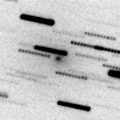
|
Brightened very rapidly. Now it is so bright as 10.2 mag and visible visually (Mar. 18, Juan Jose Gonzalez). Diffuse object, with a large coma of 4.5 arcmin. It approaches to the sun down to 0.88 A.U. in mid April, and it keeps 10-11 mag until mid May. It keeps observable until it fades out, although it keeps locating somewhat low in the morning sky. However, because it is a tiny comet, it may fade out very rapidly.
Date(TT) R.A. (2000) Decl. Delta r Elong. m1 Best Time(A, h)
Mar. 19 19 30.91 -9 38.5 0.914 1.036 65 11.1 4:42 (307, 28)
Mar. 26 20 15.49 -6 12.3 0.924 0.977 61 10.6 4:31 (299, 25)
|
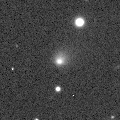
|
Already very bright, much brighter than expected, as 10.5 mag (Jan. 3, Alexandre Amorim). It is expected to keep so bright as 6-8 mag for a long time from 2011 to 2012, and to be observable in good condition in the Northern Hemisphere. It is appearing in the morning sky in the Southern Hemisphere. In the Northern Hemisphere, it will be observable in late April.
Date(TT) R.A. (2000) Decl. Delta r Elong. m1 Best Time(A, h)
Mar. 19 22 37.19 -16 32.8 4.649 3.764 24 12.2 4:42 (282,-12)
Mar. 26 22 41.04 -15 29.8 4.531 3.696 29 12.0 4:31 (283, -8)
|
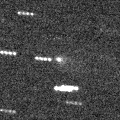
|
Now it is 14.5 mag (Mar. 4, A. Novichonok and D. Chestnov). It will be fading after this. The condition in this apparition is bad. It will be getting higher gradually after this in the Southern Hemisphere, however, it keeps extremely low until May in the Northern Hemisphere.
Date(TT) R.A. (2000) Decl. Delta r Elong. m1 Best Time(A, h)
Mar. 19 21 8.83 -21 37.8 2.192 1.644 44 13.1 4:42 (299, 2)
Mar. 26 21 27.97 -20 44.8 2.179 1.672 47 13.3 4:31 (298, 3)
|

|
Now it is 12.2 mag and visible visually (Mar. 7, Juan Jose Gonzalez).
Date(TT) R.A. (2000) Decl. Delta r Elong. m1 Best Time(A, h)
Mar. 19 10 53.62 0 16.6 5.283 6.251 165 13.6 23:06 ( 0, 55)
Mar. 26 10 50.81 0 32.1 5.315 6.252 158 13.6 22:36 ( 0, 55)
|

|
Big asteroid discovered in 1906. It suddenly showed the cometary activity on Dec. 11, probably due to an impact of a small object. It was very bright as 11.5 mag visually (Dec. 17, Juan Jose Gonzalez). It had a dust coma still on Jan. 9 (Joseph Brimacombe). Now it is stellar at 13.5 mag (Mar. 7, Juan Jose Gonzalez).
Date(TT) R.A. (2000) Decl. Delta r Elong. m1 Best Time(A, h)
Mar. 19 9 3.33 36 13.3 2.246 2.957 127 13.9 21:17 (180, 89)
Mar. 26 9 1.41 35 51.3 2.308 2.946 120 14.0 20:47 (180, 89)
|
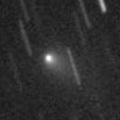
|
Now it is 14.3 mag, and already visible visually (Mar. 7, Juan Jose Gonzalez). It will brighten up to 11.5 mag in autumn. In the Northern Hemisphere, it keeps observable for a long time until 2012 spring. In the Southern Hemisphere, it is not observable until November. A small outburst occured and it brightened by 2 mag on 2010 Aug. 31 (Bernhard Haeusler).
Date(TT) R.A. (2000) Decl. Delta r Elong. m1 Best Time(A, h)
Mar. 19 18 12.03 54 0.6 2.635 2.780 87 14.0 4:42 (216, 64)
Mar. 26 18 21.23 58 21.7 2.574 2.727 87 13.9 4:31 (207, 62)
|
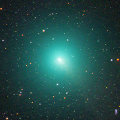
|
It approached to the earth down to 0.12 A.U. and brightened up to 4.6 mag in October (Oct. 18, Juan Jose Gonzalez). It was very large, double of the full moon, and very bright, visible with naked eyes. Now it is fading, but still bright as 12.5 mag (Mar. 7, Juan Jose Gonzalez). After this, it keeps observable for a long time until June when it fades down to 17 mag.
Date(TT) R.A. (2000) Decl. Delta r Elong. m1 Best Time(A, h)
Mar. 19 7 33.26 1 53.4 1.409 2.043 115 14.3 19:47 ( 0, 57)
Mar. 26 7 41.03 2 49.0 1.533 2.104 110 14.7 19:40 ( 6, 58)
|
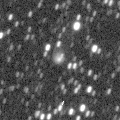
|
Now it is 13.7 mag (Mar. 7, Hidetaka Sato). It can be visible visually. It keeps bright as 14-15 mag for a long time after this until 2013. It is not observable in the Northern Hemisphere, but it is observable in good condition in the Southern Hemisphere.
Date(TT) R.A. (2000) Decl. Delta r Elong. m1 Best Time(A, h)
Mar. 19 16 38.30 -73 50.1 5.690 5.849 94 14.4 4:42 (359,-19)
Mar. 26 16 35.19 -75 23.5 5.605 5.830 98 14.4 4:25 ( 0,-20)
|
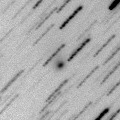
|
Now it is 13.3 mag, much brighter than originally expected and visible visually (Jan. 24, Juan Jose Gonzalez). In the Southern Hemisphere, it will be unobservable until late April. In the Northern Hemisphere, the altitude will be lower than 10 degree from February to April.
Date(TT) R.A. (2000) Decl. Delta r Elong. m1 Best Time(A, h)
Mar. 19 22 57.85 20 15.0 3.444 2.575 24 14.5 4:42 (249, 5)
Mar. 26 23 5.59 19 28.7 3.462 2.592 24 14.6 4:31 (251, 7)
|
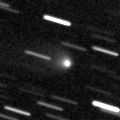
|
It has been bright as 14.5 mag and visible visually already in last autumn (Sept. 30, Alan Hale). It is appearing in the morning sky in the Northern Hemisphere. It will be observable in late March also in the Southern Hemisphere. It will be observable at 13-14 mag for a long time from 2011 to 2012.
Date(TT) R.A. (2000) Decl. Delta r Elong. m1 Best Time(A, h)
Mar. 19 20 30.44 -5 58.0 6.506 5.924 50 14.9 4:42 (292, 19)
Mar. 26 20 30.72 -5 45.8 6.379 5.899 57 14.8 4:31 (295, 23)
|
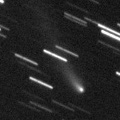
|
Now it is 13.5 mag and visible visually (Feb. 4, Juan Jose Gonzalez). It has a long tail by CCD observations. It will be unobservable soon in the Northern Hemisphere. In the Southern Hemisphere, it becomes low temporarily in May and June, but it keeps observable for a long time.
Date(TT) R.A. (2000) Decl. Delta r Elong. m1 Best Time(A, h)
Mar. 19 4 31.54 -17 9.8 3.149 2.969 70 15.2 19:34 ( 45, 24)
Mar. 26 4 32.44 -17 27.3 3.248 2.979 65 15.3 19:40 ( 51, 19)
|
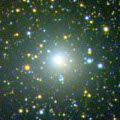
|
It reached up to 7.7 mag in 2009 summer (2009 Aug. 13, Chris Wyatt). Now it is fading, but still bright as 13.7 mag (Feb. 7, A. Novichonok, D. Chestnov). It will never be observable again in the Northern Hemisphere. In the Southern Hemisphere, it keeps observable in good condition until 2011 autumn when it becomes fainter than 18 mag.
Date(TT) R.A. (2000) Decl. Delta r Elong. m1 Best Time(A, h)
Mar. 19 18 23.70 -57 16.0 6.360 6.352 85 15.6 4:42 (344, -6)
Mar. 26 18 21.94 -58 13.3 6.303 6.400 91 15.6 4:31 (347, -6)
|
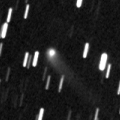
|
Now it is 16.2 mag (Mar. 7, J. Soulier, J. F. Soulier). It will be fading very slowly after this. In the Northern Hemisphere, it keeps observable for a long time until 2012 spring when it fades down to 17-18 mag. It will not be observable in the Southern Hemisphere.
Date(TT) R.A. (2000) Decl. Delta r Elong. m1 Best Time(A, h)
Mar. 19 21 29.34 38 7.6 5.280 4.717 50 15.8 4:42 (243, 31)
Mar. 26 21 38.34 38 59.4 5.284 4.734 51 15.9 4:31 (242, 33)
|
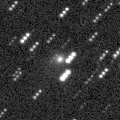
|
Now it is 14.2 mag (Feb. 7, Artyom Novichonok), much brighter than originally expected. It will be fading after this. It keeps observable in good condition in the Southern Hemisphere. In the Northern Hemisphere, it becomes observable in the evening low sky only in March and April.
Date(TT) R.A. (2000) Decl. Delta r Elong. m1 Best Time(A, h)
Mar. 19 5 43.15 -35 5.9 3.015 3.136 87 16.0 19:34 ( 21, 17)
Mar. 26 5 43.82 -31 32.4 3.115 3.166 83 16.2 19:40 ( 29, 17)
|
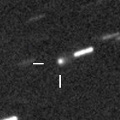
|
It will approach to the sun down to 0.5 A.U. in September, and it is expected to brighten up to 6 mag. Now it is 15.7 mag (Mar. 12, P. C. Sherrod). It will be brightening gradually. In the Southern Hemisphere, it keeps observable until early September when it becomes 7 mag. In the Northern Hemisphere, it becomes unobservable in August. But after appearing in the morning sky in October, it becomes observable in the excellent condition at midnight.
Date(TT) R.A. (2000) Decl. Delta r Elong. m1 Best Time(A, h)
Mar. 19 11 28.57 1 52.5 2.051 3.043 173 16.4 23:41 ( 0, 57)
Mar. 26 11 19.60 2 47.4 1.979 2.953 164 16.2 23:04 ( 0, 58)
|
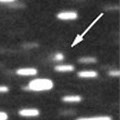
|
Now it is 16.2 mag (Mar. 8, E. Bryssinck). It keeps 16 mag for a while. In the Northern Hemisphere, it will be getting lower gradually after this, and it will be unobservable in July . In the Southern Hemisphere, it keeps locating low.
Date(TT) R.A. (2000) Decl. Delta r Elong. m1 Best Time(A, h)
Mar. 19 5 25.58 37 54.8 2.143 2.287 85 16.3 19:34 (106, 67)
Mar. 26 5 37.16 37 46.9 2.203 2.268 80 16.2 19:40 (106, 63)
|
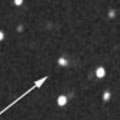
|
Now it is 16.5 mag (Mar. 1, P. C. Sherrod). It keeps 15 mag from 2011 summer to 2012 summer. But it is not observable around the perihelion. It is observable in good condition in the Northern Hemisphere in 2011, and in the Southern Hemisphere in 2012.
Date(TT) R.A. (2000) Decl. Delta r Elong. m1 Best Time(A, h)
Mar. 19 13 38.56 23 49.5 2.868 3.731 145 16.5 1:55 ( 0, 79)
Mar. 26 13 36.05 24 48.3 2.799 3.678 147 16.4 1:25 ( 0, 80)
|
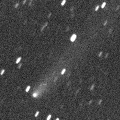
|
Now it is 17.3 mag (Mar. 8, P. Dupouy). It keeps observable after this while fading gradually.
Date(TT) R.A. (2000) Decl. Delta r Elong. m1 Best Time(A, h)
Mar. 19 13 1.55 -27 31.3 1.936 2.824 147 16.6 1:18 ( 0, 27)
Mar. 26 12 54.83 -26 48.3 1.941 2.868 153 16.7 0:44 ( 0, 28)
|

|
It had been bright as 13-14 mag for a long time from 2007 to 2009. Now it is fading, but it is still bright as 14.4 mag and visible visually (Feb. 7, Sandor Szabo). It is observable in good condition in the Northern Hemisphere. It locates low in the Southern Hemisphere.
Date(TT) R.A. (2000) Decl. Delta r Elong. m1 Best Time(A, h)
Mar. 19 11 7.11 42 33.1 8.937 9.689 137 16.9 23:20 (180, 82)
Mar. 26 11 1.99 42 37.9 9.026 9.725 132 16.9 22:47 (180, 82)
|
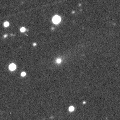
|
Now it is 17.7 mag (Mar. 7, W. Hasubick). It was observed around 16 mag in 2009 and 2010. In 2011, it keeps observable at 17 mag from spring to autumn. It locates somewhat low in the Northern Hemisphere.
Date(TT) R.A. (2000) Decl. Delta r Elong. m1 Best Time(A, h)
Mar. 19 17 35.10 -22 27.1 3.850 4.037 93 17.0 4:42 (341, 30)
Mar. 26 17 37.92 -22 33.6 3.753 4.046 99 17.0 4:31 (345, 31)
|
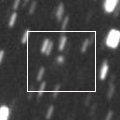
|
Now it is 17.0 mag (Feb. 4, D. Chestnov and A. Novichonok). In the Northern Hemisphere, it keeps observable at 17 mag in good condition until summer. It locates low in the Southern Hemisphere.
Date(TT) R.A. (2000) Decl. Delta r Elong. m1 Best Time(A, h)
Mar. 19 18 7.07 25 58.9 3.939 4.013 87 17.0 4:42 (286, 66)
Mar. 26 18 2.31 27 58.3 3.857 4.026 92 17.0 4:31 (287, 72)
|
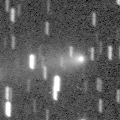
|
It reached up to 14.0 mag and became visible visually in December (Dec. 17, Juan Jose Gonzalez). It keeps locating high in the Northern Hemisphere after this. But it will be fading. It has already faded down to 16.6 mag (Mar. 1, Tzec Maun Observatory). It will be fainter than 18 mag in April. It locates low in the Southern Hemisphere.
Date(TT) R.A. (2000) Decl. Delta r Elong. m1 Best Time(A, h)
Mar. 19 6 36.02 43 47.0 2.124 2.475 98 17.3 19:34 (140, 78)
Mar. 26 6 45.53 43 27.1 2.230 2.501 93 17.5 19:40 (128, 74)
|

|
It was observed only during 3 days in 2009 May, then it has been lost. The ephemeris says that it passes the perihelion in 2011 January and it will be observable at 17 mag. But actually, it will not be found.
Date(TT) R.A. (2000) Decl. Delta r Elong. m1 Best Time(A, h)
Mar. 19 5 26.58 -10 4.4 3.933 3.947 83 17.4 19:34 ( 36, 38)
Mar. 26 5 22.96 -9 6.3 4.063 3.957 76 17.5 19:40 ( 46, 33)
|
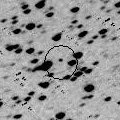
|
Large Centaur-type asteroid. Now it is 17.0 mag (Jan. 7, Tzec Maun Observatory). It keeps observable at 17-18 mag for a long time until 2013.
Date(TT) R.A. (2000) Decl. Delta r Elong. m1 Best Time(A, h)
Mar. 19 7 14.56 -7 7.5 6.074 6.487 110 17.6 19:34 ( 2, 48)
Mar. 26 7 13.12 -6 2.2 6.174 6.487 103 17.6 19:40 ( 15, 48)
|
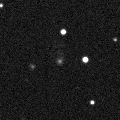
|
Now it is 17.3 mag (Feb. 21, Ken-ichi Kadota). It is fading slowly. In the Northern Hemisphere, it keeps observable in good condition until 2011 summer. It is not observable in the Southern Hemisphere.
Date(TT) R.A. (2000) Decl. Delta r Elong. m1 Best Time(A, h)
Mar. 19 17 37.20 45 59.0 5.314 5.461 93 17.6 4:42 (226, 73)
Mar. 26 17 34.53 46 30.9 5.291 5.486 96 17.6 4:31 (216, 75)
|

|
It is expected to keep 14-15 mag for a long time from 2011 summer to 2012 summer. The condition is good in the Southern Hemisphere, and it keeps observable for a long time. In the Northern Hemisphere, it is observable in the low sky in 2011 spring. But after that, it is not observable until 2012 August. However, this comet was observed only during two days in 2010 June. So the orbital elements are extremely uncertain.
Date(TT) R.A. (2000) Decl. Delta r Elong. m1 Best Time(A, h)
Mar. 19 18 27.33 -24 47.7 4.173 4.148 81 17.8 4:42 (330, 24)
Mar. 26 18 29.94 -25 40.9 4.002 4.092 88 17.6 4:31 (333, 24)
|
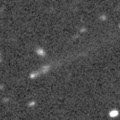
|
Now it is 17.6 mag (Feb. 24, La Sagra). It tends to be brightest after the perihelion passage. At the discovery in 1999, it became brightest one year after the perihelion passage. At this time, it became brightest three months after the perihelion passage, then it is fading. It keeps observable in good condition at 18 mag until may.
Date(TT) R.A. (2000) Decl. Delta r Elong. m1 Best Time(A, h)
Mar. 19 9 59.28 9 20.1 2.896 3.795 150 17.6 22:12 ( 0, 64)
Mar. 26 9 56.63 9 35.0 2.968 3.812 143 17.7 21:42 ( 0, 65)
|
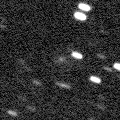
|
Now it is 16.7 mag (Feb. 16, L. Elenin and A. Novichonok). Diffuse object, but the total magnitude is bright. It keeps 17-18 mag until April.
Date(TT) R.A. (2000) Decl. Delta r Elong. m1 Best Time(A, h)
Mar. 19 14 43.55 -10 27.4 0.907 1.763 135 17.8 3:00 ( 0, 45)
Mar. 26 14 41.81 -10 35.8 0.893 1.794 143 17.8 2:31 ( 0, 44)
|
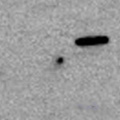
|
Now it is 17.8 mag (Mar. 5, C. Rinner, F. Kugel). It brightens up to 12 mag in autumn. But the condition is bad. In the Northern Hemisphere, the altitude will be lower than 20 degree in June when it brightens up to 15 mag, then it will be unobservable in August. After the perihelion passage, it is only observable from December to February in the evening very low sky. In the Southern Hemisphere, it keeps observable for a long time, although it keeps locating extremely low.
Date(TT) R.A. (2000) Decl. Delta r Elong. m1 Best Time(A, h)
Mar. 19 8 53.92 33 20.7 1.888 2.612 127 18.0 21:07 ( 0, 88)
Mar. 26 8 48.86 33 12.1 1.913 2.557 119 17.8 20:34 ( 0, 88)
|
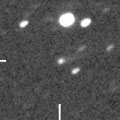
|
Now it is 17.4 mag (Feb. 24, La Sagra). It was observed at 18 mag in winter between 2009 and 2010. It will be observable again at 18 mag in good condition from winter to spring in 2011.
Date(TT) R.A. (2000) Decl. Delta r Elong. m1 Best Time(A, h)
Mar. 19 10 30.17 14 14.4 2.562 3.493 155 17.9 22:43 ( 0, 69)
Mar. 26 10 26.94 14 33.2 2.613 3.499 148 17.9 22:12 ( 0, 70)
|
|
![]()
 2008 YB3
2008 YB3 C/2007 VO53 ( Spacewatch )
C/2007 VO53 ( Spacewatch ) C/2010 M1 ( Gibbs )
C/2010 M1 ( Gibbs ) 203P/2008 R4 ( Korlevic )
203P/2008 R4 ( Korlevic ) P/2011 A2 ( Scotti )
P/2011 A2 ( Scotti ) 73P/Schwassmann-Wachmann 3
73P/Schwassmann-Wachmann 3 31P/Schwassmann-Wachmann 2
31P/Schwassmann-Wachmann 2![]()



























